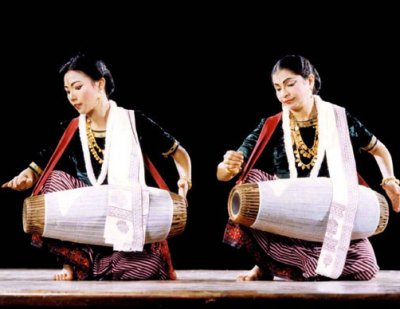
|   |

|   |
Exquisite Manipuri dances - Vijay Shanker, Mumbai e-mail: vijaydance@gmail.com January 14, 2013 National Centre for the Performing Arts (NCPA) presented a Manipuri dance lecture-demonstration by renowned dancer Darshana Jhaveri and her disciples Latasana Devi and Gyaneshwari at NCPA’s Little Theatre on 21st December. The presentation traced the significance, the social and religious aspect of Manipuri dances, its transition from the temples to the auditorium and the immense contribution of Guru Bipin Singh and the Jhaveri Sisters in placing Manipuri dance on the international platform. Late Nayana Jhaveri and her sisters Ranjana, Suvarna and Darshana, in spite of being non- Manipuris are credited for the promotion and propagation of Manipuri dances. With the support and guidance of their mentor late Guru Bipin Singh, the Jhaveri Sisters after research in the varied types of Manipuri dances, established the Manipuri Nartanalaya in order to encourage young aspirants in this exquisite form of dancing. Darshana explained as to how Manipuri dances forms an integral part of life. Every occasion whether social or religious is considered incomplete without the presentation of Manipuri dances. For the birth of a child, marriage, death or any festive occasion, Manipuri dances are performed. The different dances performed are Sankirtan (invocatory), Raas Leela (dance with Krishna and gopis), Lei Haroba (festive dance), Pung Cholom (dance of the drums), Kartal Cholom (dance with cymbals) and Thangta (martial dance). Commencing with simple movements, the dancers demonstrated as to how the complete dance was learnt and performed. In Krishna Tandava, the dancer sits and jumps and also gets into "brahmaris" (spiral movements) which is not easy as it is a circular movement where you have to move in circles while balancing on just one foot and it takes years to master this acrobatic movement. This movement is also the highlight in the Pung Cholom drum dance wherein the dancer dances and plays the drum simultaneously and also moves in circles balancing on the feet. The drum dance was performed by the drummer Brojen and the varied rhythmic patterns on the drum were played by Latasana and Gyaneshwari. Initially the drum dance was performed only by males, but Guru Bipin Singh introduced this dance to his female students too and the Jhaveri Sisters were the foremost in learning this dance. In all their performances, the drum dance is always the highlight.  Darshana demonstrated varied rhythmic Tala patterns from 4 to 68 beats. The Talas are known as Brahma Tala of 28 beats and 10 stress, Rupak of 6 beats, Sankirna of 14 beats and Tal Deshkesh of 7 beats and 5 stress. The Kaliya Dhaman dance wherein Krishna dances in rhythm and kills the serpent Kaliya was demonstrated well. This item also revealed as to how the body language or Angika abhinaya is used to portray a particular character or expression. It was quite an enjoyable program, particularly as the costumes are really colourful and beautiful and the dancers performed with lot of devotion and involvement. Vijay Shankar is a Kuchipudi and Kathakali exponent, teacher, bilingual journalist, arts critic and actor. |